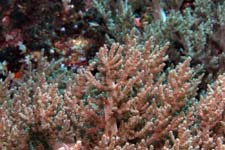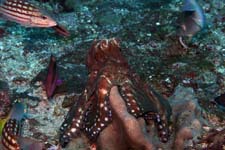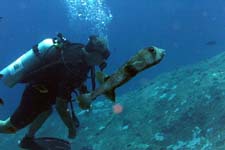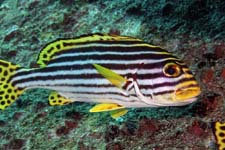Similan Diving
How are the Corals?
The Similan Islands are renowned as one of the top scuba diving destinations in the world. They are a draw for diving enthusiasts from all around the globe and many come to Phuket before they head out to the Similans on a liveaboard dive cruise. Similan diving is famous for its underwater granite boulders, clear visibility, teeming sea-life and beautiful corals.
 Well maybe we need to strike beautiful coral off the list. Recently, nature
has been giving the corals a tough time. First there was the 2004 tsunami
and then in 2010 there was a coral bleaching event that affected many coral
reefs around the world. So just how much have the corals in the Similans
suffered?
Well maybe we need to strike beautiful coral off the list. Recently, nature
has been giving the corals a tough time. First there was the 2004 tsunami
and then in 2010 there was a coral bleaching event that affected many coral
reefs around the world. So just how much have the corals in the Similans
suffered?
We have to say, they have suffered a lot. We are not suggesting that the Similans no longer have anything to offer as a dive destination. When conditions are good the visibility is excellent and the underwater granite boulders are spectacular. The sea still teems with all manner of life. Shoals of colourful fish dance about the reefs while the silhouettes of barracuda hover above. Turtles are a regular site and moray eels wriggle around the rocks. You see new and interesting varieties of sea-life on every dive. The Similans are still a fantastic destination for viewing sea-life.
While the swarming fish may be the main act, it is the corals that are the stage. The corals are the colourful backdrop that the sea-life performs upon and we have to say that right now the show is being played on a rather drab set.
 The 2004 tsunami did cause a lot of damage and there are still areas where
you see a lot of broken and flattened coral. However, the damage from the
tsunami was limited to just a few exposed reefs and even then only in the
shallower waters. Many of these damaged reefs were already showing signs
of recovery.
The 2004 tsunami did cause a lot of damage and there are still areas where
you see a lot of broken and flattened coral. However, the damage from the
tsunami was limited to just a few exposed reefs and even then only in the
shallower waters. Many of these damaged reefs were already showing signs
of recovery.
The real problem came with the bleaching in 2010. Corals start to bleach when the water temperature rises to 31°C. In April 2010, surface temperatures in the Andaman Sea reached 34°C and were 32°C at 20 meters. Thailand's diving community watched helplessly as the corals started to bleach. While the majority of corals were sheltered from the tsunami, there was no hiding from this event. Entire reefs appeared to be dying. It was a long and hot dry season. The cooling rains that usually arrive in April were late. The corals just kept bleaching.
This event was not limited to Thailand. Reefs around much of Southeast Asia and the rest of the world suffered. The Similan Marine National Park closes from May to October for the rainy season. When it re-opened the extent of the damage became clear. There were great fields of bleached, apparently dead coral. The soft corals had survived better and in the deeper waters below 20-meters the hard corals endured. However, the hard corals in the shallow waters had suffered devastation. There were great fields of brittle, white, lifeless coral. The extent of the damage is unparalleled in the time since the corals have been monitored.
 There is still some debate about whether the global warming that ultimately
caused this event is man-made or natural, although the overwhelming weight
of credible evidence says it is man-made. The Similans has been suffering
from other man-made problems. There have been many reports of illegal fishing
activities within the bounds of the marine national park.
There is still some debate about whether the global warming that ultimately
caused this event is man-made or natural, although the overwhelming weight
of credible evidence says it is man-made. The Similans has been suffering
from other man-made problems. There have been many reports of illegal fishing
activities within the bounds of the marine national park.
There are still lots of fish around the Similans but sightings of big species such as sharks and mantas have become less common. While many of the diving brochures still give great prominence to the possibility of seeing a whale shark, most of the liveaboard divemasters privately admit to few if any sightings over the last couple of years.
The Similans does still offer a fantastic diving experience. The variety of sea-life is still extraordinary even with the loss of so much coral. The big question is when or if the coral will recover to its former glory. What, if anything, can be done to speed the recovery of the coral?
 The Marine Parks and the Tourism Authority of Thailand have taken the interesting
step of closing many of the worst hit dive sites. Whether this action will
be of any benefit remains to be seen. While there is no doubt that
coral reefs do suffer from the occasional diver's stray fin and the
actions of an irresponsible few, the vast majority of scuba divers are very
conscious of the need to preserve the environment they enjoy visiting so
much. Certainly closing these dive sites is not going to give them any protection
from the forces that caused the bleaching in the first place. Still it is
an interesting experiment and we wait to see if the corals at the closed
sites recover any quicker than the corals at the sites that remain open.
The Marine Parks and the Tourism Authority of Thailand have taken the interesting
step of closing many of the worst hit dive sites. Whether this action will
be of any benefit remains to be seen. While there is no doubt that
coral reefs do suffer from the occasional diver's stray fin and the
actions of an irresponsible few, the vast majority of scuba divers are very
conscious of the need to preserve the environment they enjoy visiting so
much. Certainly closing these dive sites is not going to give them any protection
from the forces that caused the bleaching in the first place. Still it is
an interesting experiment and we wait to see if the corals at the closed
sites recover any quicker than the corals at the sites that remain open.
The Great Barrier Reef in Australia has suffered similar coral bleaching on many occasions including a major event in 2002. Every time, the vast majority of the coral has recovered within a year. We can only hope that the coral around Thailand will be equally resilient but at the moment vast fields of it appear to be dead. We optimistically hope that the next diving season at the Similans will reveal a remarkable recovery but we fear that it may actually take years for a full recovery. Even then, there is still the possibility that man-made climate change will mean these bleaching events will occur more frequently with some scientists predicting coral bleaching will be an annual event by 2030. Could the world's coral reefs survive such a beating? What a tragedy if these magnificent eco-systems are lost forever.
